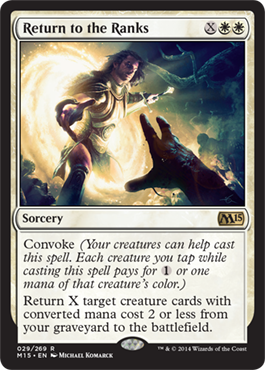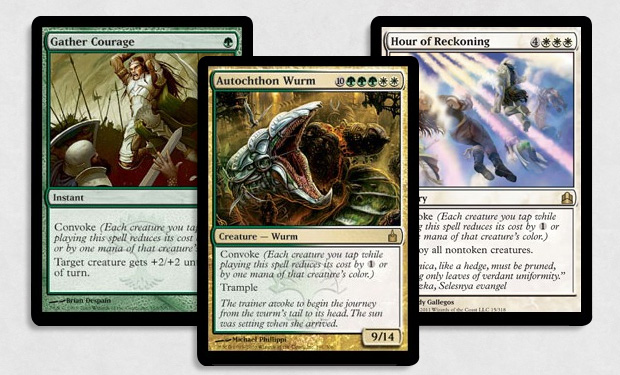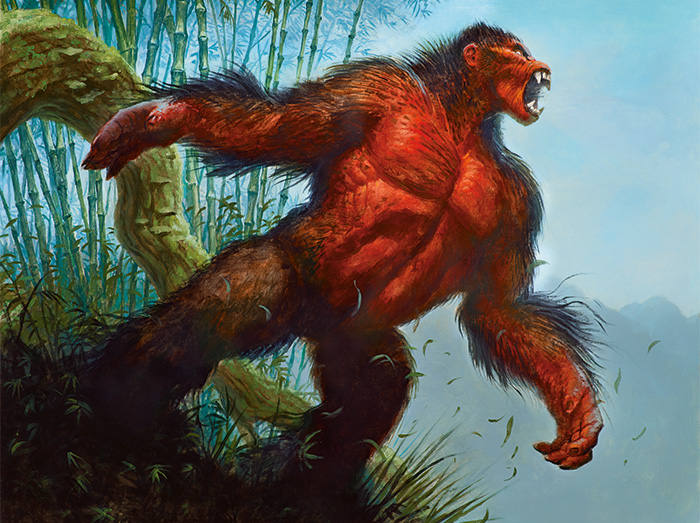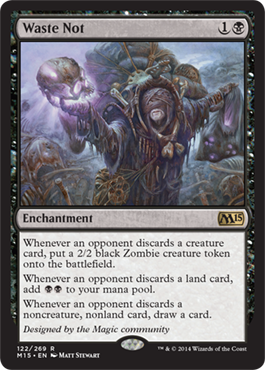Days of Core, Part 1
Welcome to the first Magic 2015 Preview Week. This week and next, I'll be walking you through the design of the latest core set, including introducing you to the design team and showing off a new preview card. There's a lot to get through so let's get started.
Design Up Ahead
Let me begin today by introducing the design team that assembled Magic 2015.

Aaron Forsythe (lead designer)
As senior director of Magic R&D, Aaron is busy making sure the rest of Magic R&D has the resources it needs to do its job, but he still enjoys getting his hands dirty from time to time doing some design or development. He usually only has time for one project each year, and this year he chose to lead the design of the core set. The major reworking of the core set with Magic 2010 (that's the set that added new cards to the core set among other things) was the brainchild of Aaron, and the core sets have become a pet favorite of his.
For those unfamiliar with Aaron's history at Wizards, he was originally hired to run DailyMTG.com when it first went live (back then called magicthegathering.com). We put him on the design team for Fifth Dawn to allow him a chance to write a behind-the-scenes article, but Aaron did such amazing work that we brought him into R&D. Aaron then started down the path of a designer only to shift when the job of head developer opened up. Shortly after that, the director job became vacant and Aaron ended up in his current position.
While Aaron does a great job as the director, I miss the days of getting to work with him more as a designer. I'm happy, though, that he still gets the occasional product like Magic 2015 to stretch his muscles and, as the product shows, he hasn't lost his touch.

Max McCall
To me, Max's claim to fame will always be that he was the one person of more than 2,000 applicants over two Great Designer Searches to have a perfect score on the multiple-choice test. Max spent a number of years working for the Magic digital department on projects like Duels of the Planeswalkers and Magic Online. Like most of the digital department, Max enjoyed getting the chance to work on the occasional analog project (i.e., "paper") and was very excited to work on Magic 2015. Max has a very keen insight into what makes the game click and brought the same attention he used on the digital side to Magic 2015's design. Max has since left Wizards to work on some other games and he is missed.

Shawn Main
Shawn was the one core designer working on the Magic 2015 design team. Shawn just passed his three-year anniversary working at Wizards and it's clear from watching things like Conspiracy that he's clearly hit his stride. I believed strongly when Shawn came in 2nd in the second Great Designer Search that he had a lot of potential, and watching the potential come to fruition has been a joy. There's so much cool stuff Shawn has done that's in the future for all of you that I know I'm going to have a lot more bios to write. Magic 2015 is another point in the line of his rising star, and as always he did an excellent job.

Jenna Helland
Every bio about Jenna, I always talk about how she came on as the creative team representative and then went on to kick ass as an excellent design team member. This story, though, only works for so long before everyone catches onto the fact that Jenna is just a great addition to any design team. She obviously brings a strong knowledge of the creative elements but she also has the talent to design cards that really resonate, which is particularly useful for a core set that has a little less overall story and a little more card-by-card resonance. So, this time, I'm just going to say that Jenna did her normal, expected, wonderful work as a member of the design team.

Mike Gills
Most design teams have what we call the "fifth member." This slot is reserved for someone who has spent years working on Magic but hasn't yet had the chance to be on a design or development team. The idea behind the "fifth member" is that it brings fresh blood to a design and allows the design team to get a perspective that has yet to find a voice in cards. Mike spent many years working in our organized play department and was sitting on the short list for a "fifth member" for numerous years. I'm happy that Mike not only finally got his chance to serve on a design team but did a great job at it. Like Max, Mike has since gone on to lend his skills elsewhere.
Room with a Preview
So without further ado, click here to meet Return to the Ranks.

There's a bunch to say about this card, so let's start with the return of convoke. Convoke was first created in Ravnica design by team member Richard Garfield. He called it crittercast and designed it for Boros (red/white). He felt it had the feel of an army working together. While I agreed it could work in Boros, I felt it actually was a better choice for our Selesnya (green/white) mechanic. Here are the reasons:
First, we wanted Boros to be our most aggressive guild and taking time to tap your creatures to play spells rather than tapping them to attack worked against this goal. Selesnya, on the other hand, was a slower, ramping deck. It wanted to get out a lot of creatures and eventually overwhelm you. Convoke played into exactly what this deck needed—a means to quickly get out larger creatures. It didn't matter that you were tapping some as this deck usually was willing to trade aggression for long-term buildup.
Selesnya was also the better choice because the mechanic was all about rewarding you for playing a lot of creatures, and having lots of creatures was a key part of Selsenya's identity. Being the green/white guild, it was very tied into community and its power came from its creatures all working together—something convoke conveyed strongly. Convoke also turned out to be a wonderful mechanic because it could work on any card type and it didn't fight itself, meaning that if you wanted a lot of convoke cards in your deck, you could do that.
Convoke also ended up filling multiple roles. It could allow you to play a cheap surprise spell when you were tapped out, it let you get a giant creature onto the battlefield much sooner than normal, and it even allowed you to commit all your creatures to play a giant spell.

In fact, convoke worked so well during Ravnica design that I knew it would be back one day. It's clean, not too texty, plays well, and does something unique in that it turns creatures essentially into mana. The big question was just which environment would we bring back convoke for?
Flashback to Magic 2011. Aaron had just completed Magic 2010, which rewrote what it meant to be a core set. As he started the lead design on Magic 2011, he was thinking whether there was anything else he could add to the core set that he didn't the year before. That's when Aaron came up with the idea of bringing back a mechanic. You see, R&D figured out that we create new cool mechanics faster than we use old cool mechanics, meaning that we tend to create a stockpile of cool mechanics that we want to do again but just didn't have many slots to use. (This is also, by the way, why we are being influenced to start bringing back more than one mechanic a year—see Theros block as an example.) What if the core set made use of some of the nice, simple mechanics from Magic's past?
Besides adding splash, this would solve a different problem, which was how to make core sets feel different from one another. When the core set is defined by lots of cool individual cards, it's hard to create an overall feel. By adding in a simple mechanic, the design team could have something to craft Limited play around. Aaron and his team set out to make a list of potential returning mechanics. At the top of the list were the mechanics that were simple to understand but that added a new play pattern, meaning they functioned as a seasoning that would flavor the new core set. Near the top of that list was convoke. It wasn't a question of if the core set would ever use convoke—just when.
As for the ability of Return to the Ranks, that's a different, but equally interesting story. So, white is the color with the most answers. It's the color of structure and order, so it plans ahead and makes sure it has tools in its arsenal to deal with whatever problems come its way. That is one of the advantages of organization.
To offset this, we have made white the worst color at card drawing. If white could draw cards too efficiently, it would be able to find its answers too consistently. Meanwhile, we want white to be the color of the army. We want white to have the most creatures, most of which we want small and working together. (Green is the creature color that builds up to getting a single larger creature.) The problem with having lots of little creatures is that you quickly run out of them.
How do we keep white with having an ongoing stream of small white creatures when having lots of cheap creatures tends to run you out of cards? The obvious answer is to let white draw cards, but, as I explained above, for other reasons, we don't want white drawing cards aggressively. The key is figuring out how we can get white more small white creatures without drawing more cards that might be spells that serve as answers. The first answer was token making. By using tokens, we allow white to make small creatures at a rate of better than one per card. A spell can make multiple tokens. A creature can make a token. Permanents can continually make tokens. But tokens only get us so far.
So we were looking for another way to solve this problem. In Alpha, white had this card:
The idea was that white could do creature reanimation but not as efficiently as black. (Black had cards like Animate Dead, which reanimated for two mana.) With time, though, we realized that reanimation had to cost a lot more, and now black does it for four and five mana, and only at uncommon and up, which didn't leave any room for white.
Then it dawned on us that white didn't really need to get big creatures out of the graveyard because most of its cards were cheap and small. What if we let white reanimate tiny creatures? This would help white refill its army without giving it access to the things we don't want white to easily get. We spent some time going back and forth between having a low power and having a low converted mana cost. At first, we leaned toward power, as the concept is easier to understand, but what we found was that there were many powerful and expensive low-powered creatures, and if we allowed white to get those creatures we would have to cost the spells such that it would only be able to use it to do the broken things and wouldn't have the common usage we wanted for it.
The reason that Return to the Ranks is such a cool design is that both ends play so nicely into white's army theme. The spell lets you get back a lot of creature only if you have a lot of creatures. This allows white to keep spilling out a stream of small creatures and, just when it is running out, it can use the creatures it has to get back all the ones it lost in the early part of the game. Also, having X in convoke costs is just plain fun, especially in the color that gets to have lots of creatures.
But Wait, There's More
So Magic 2015 would make new cards like Magic 2010 and bring back a popular mechanic like Magic 2011 (Aaron's last two core set design leads), but Aaron still wanted something brand new. How could he add something to the set that had never been added before?
That is when Aaron came up with an interesting idea.

Art by Lars Grant-West
Through the years, we've heard a lot about how other game designers have been influenced by Magic. It has become the 800-pound gorilla in core gaming and it's hard for people into gaming not to at least get exposed to it. Also, as Magic is very good at allowing customizability, it tends to attract game designers because it plays into their love of crafting games. We've heard time and again how Magic has directly led to the design of other classic games (such as Plants vs. Zombies—which I talk about a bit in this article). One cool new way to breathe new life into the core set would be to go seek out some people who have never designed for Magic before and let them make cards. To ensure that we'd get some cool designs, what if that subset of people were famous game designers who play Magic?
Now, tracking down which game designers played Magic and who would be interested in designing cards (and were able to and had the time) was a lengthy and complex process. In the end, we found fourteen outside designers able to design cards. But fourteen seemed like a strange number. Luckily, while this promotion was happening, so too was a different one.
Back in 2002, I came up with an idea for a little promotion to run on the website. It had been our goal to use the website to give the players more direct access to the game, so we'd been looking for ways to let the players have more of a direct say in things. I dubbed my idea "You Make the Card." The idea was simple. We would have a series of votes where every decision was made by the public, and, when it ended, it would result in a card that we would then print in a set. The first "You Make the Card" resulted in the creation of this card:
Forgotten Ancient (with the design name Mr. Babycakes) was published in the set Scourge. We then did a second and a third "You Make the Card," resulting in the cards Crucible of Worlds (printed in Fifth Dawn) and Vanish into Memory (printed in Coldsnap). "You Make the Card 2" was done mostly the same way as the original, but "You Make the Card 3" had a twist. Instead of starting with color or card type, we started with art. With the art selected, we then had the audience do a top-down design.
Vanish into Memory ended up being a big miss (top-down design is very hard) and the "You Make the Card" promotion got put on the back burner. From time to time, we'd bring up "You Make the Card," but it spent years in limbo. Trick Jarrett, then the editor-in-chief of DailyMTG.com (Trick has since received a promotion—welcome Blake Rasmussen) came to R&D asking if we ever wanted to resurrect "You Make the Card." We agreed that it had been gone too long, so we started working out what we would need to do to make a fourth installment.
Somewhere along the way, we realized that these two promotions were happening simultaneously, and Aaron asked if we could print the "You Make the Card"–winning card in Magic 2015. After all, what better outside designer could we get than all of you?
When we started, we made some bold predictions, most of which ended up coming true. Forgotten Ancient was a green creature. Crucible of Worlds was an artifact. Vanish into Memory was a white and blue multicolor instant. We assumed the audience would want to make something different than what had been done before. That meant it would most likely be black or red and be an enchantment, land, or sorcery. (We didn't let Planeswalker be a choice as it's something we both need to have more control over and would be exceedingly hard to design by committee.) As it turned out, you all chose to make a black enchantment; this black enchantment:

It took most of a year, but, piece by piece, you all designed Waste Not, a pretty cool card.
Not Quite Done
There's more to say about Magic 2015's design, but I've hit my word count for today. Luckily, we have two preview weeks. As always, I'm curious to hear any feedback on today's article. Feel free to talk to me through any of my social media outlets (Twitter, Tumblr, Google+ and Instagram).
Join me next week for Part 2 and more about Magic 2015 design.
Until then, may you enjoy Magic 2015 as much as we (and by "we" I mean inside and outside of Wizards) enjoyed making it.
"Drive to Work #132—Story Through Design"
For my first podcast this week, I talk about how we tell stories through design. Yes, art and names and flavor text can convey story and environment, but how about game play?
"Drive to Work #133—Designing Commons"
My second podcast today talks about the challenges of designing common cards. If you like the Nuts & Bolts series, this is worth a listen.
- Episode 133 : Designing Commons (14.2 MB)
- Episode 132 : Story Through Design (15.4 MB)
- Episode 131 : Story History (16.3 MB)
- Episode 130 : 2000 (13.7 MB)
- Episode 129 : Worldwake, Part 3 (16.6 MB)
- Complete Drive To Work Podcast Archive

